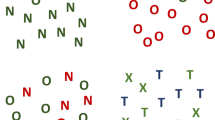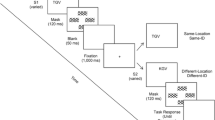Abstract
Patients with simultanagnosia, which is a component of Bálint syndrome, have a restricted spatial window of visual attention and cannot see more than one object at a time. As a result, these patients see the world in a piecemeal fashion, seeing the local components of objects or scenes at the expense of the global picture. To directly test the relationship between the restriction of the attentional window in simultanagnosia and patients’ difficulty with global-level processing, we used a gaze-contingent display to create a literal restriction of vision for healthy participants while they performed a global/local identification task. Participants in this viewing condition were instructed to identify the global and local aspects of hierarchical letter stimuli of different sizes and densities. They performed well at the local identification task, and their patterns of inaccuracies for the global level task were highly similar to the pattern of inaccuracies typically seen with simultanagnosic patients. This suggests that a restricted spatial area of visual processing, combined with normal limits to visual processing, can lead to difficulties with global-level perception.




Similar content being viewed by others
Notes
Patients with Bálint syndrome present with dorsal (as opposed to ventral) simultanagnosia (Farah 1990), which is an attentional limitation that prevents patients from seeing more than one object at a time. Thus, we define simultanagnosia in this context strictly as a reduction in attentional processing capacity that is in part reflected by a failure to process or maintain attention to a larger region of the visual field outside of the current focus of attention, as opposed to the more general definition offered by Wolpert (1924), which also includes difficulty with the interpretation of the global concept of a scene or a figure.
We do not to report reaction times (RTs) because patient SL’s responses were entered by the experimenter and are therefore unreliable. The gaze-contingent group had long trial durations, whereas the full-view group responded almost instantly; hence, any differences in RTs for these groups are relatively uninformative.
References
Bálint R (1909) Seelenlähmung des “Schauens”, optische Ataxia, räumliche Störung der Aufmerksamkeit. Monatsschrift für Psychiatrie und Neurologie 25:51–81
Bay E (1953) Disturbances of visual perception and their examination. Brain 76(4):515–550
Clavagnier S, Fruhmann Berger M, Klockgether T, Moskau S, Karnath H-O (2006) Restricted ocular exploration does not seem to explain simultanagnosia. Neuropsychologia 44:2330–2336
Crawford JR, Garthwaite PH, Howell DC (2009) On comparing a single case with a control sample: an alternative perspective. Neuropsychologia 47(13):2690–2695
Cummings J, Houlihan J, Hill M (1986) The pattern of reading deterioration in dementia of the Alzheimer type. Brain Lang 29:315–323
Dalrymple K, Kingstone A, Barton J (2007) Seeing trees OR seeing forests in simultanagnosia: Attentional capture can be local or global. Neuropsychologia 45:871–875
Dalrymple K, Bischof W, Cameron D, Barton J, Kingstone A (2009) Global perception in simultanagnosia is not as simple as a game of connect-the-dots. Vis Res 49:1901–1908
Delis D, Robertson L, Efron R (1986) Hemispheric specialization of memory for visual hierarchical stimuli. Neuropsychologia 24:205–214
Duncan J, Bundesen C, Olson A, Humphreys G, Ward R, Kyllingsbaek S et al (2003) Attentional functions in dorsal and ventral simultanagnosia. Cogn Neuropsychol 20(8):675–701
Farah M (1990) Visual agnosia: disorders of object recognition and what they tell us about normal vision. MIT Press, Cambridge
Goodglass H, Kaplan E (1983) The assessment of aphasia and related disorders, 2nd edn. Lea and Febiger, Philadephia
Hecaen H, de Ajuriaguerra J (1954) Bálint’s syndrome (psychic paralysis of visual fixation) and its minor forms. Brain 77:373–400
Holmes G, Horrax G (1919) Disturbances of spatial orientation and visual attention, with loss of stereoscopic vision. Arch Neurol Psychiatry 1:385–407
Huberle E, Karnath H-O (2006) Global shape recognition is modulated by the spatial distance of local elements—evidence from simultanagnosia. Neuropsychologia 44(6):905–911
Karnath H-O, Ferber S, Rorden C, Driver J (2000) The fate of global information in dorsal simultanagnosia. Neurocase 6:295–306
Loschky L, McConkie G, Yang J, Miller M (2005) The limits of visual resolution in natural scene viewing. Vis Cogn 12(6):1057–1092
Luria A, Pravdina-Vinarskaya E, Yarbus A (1962) Disturbances of ocular movement in a case of simultanagosia. Brain 86:219–228
McConkie G, Rayner K (1975) The span of the effective stimulus during a fixation in reading. Percept Psychophys 17:578–586
Moreaud O (2003) Bálint syndrome. Arch Neurol 60:1329–1331
Navon D (1977) Forest before trees: the precedence of global features in visual perception. Cogn Psychol 9:353–383
Pomplun M, Reingold E, Shen J (2001) Investigating the visual span in comparative search: the effects of task difficulty and divided attention. Cognition 81:B57–B67
Rafal R (2003) Bálint’s syndrome: a disorder of visual cognition. In: D’Esposito M (ed) Neurological foundations of cognitive neuroscience. MIT Press, Cambridge, pp 27–40
Rizzo M, Vecera S (2002) Psychoanatomical substrates of Bálint’s syndrome. J Neurol Neurosurg Psychiatry 72:162–178
Robertson L, Lamb M, Knight R (1988) Effects of lesions of temporal-parietal junction on perceptual and attentional processing in humans. J Neurosci 8:3757–3769
Shalev L, Humphreys G (2002) Implicit location encoding via stored representations of familiar objects: neuropsychological evidence. Cogn Neuropsychol 19(8):721–744
Shalev L, Humphreys G, Mevorach C (2004) Global processing of compound letters in a patient with Bálint’s syndrome. Cogn Neuropsychol 22(6):737–751
Shalev L, Mevorach C, Humphreys G (2007) Local capture in Bálint’s syndrome: effects of grouping and item familiarity. Cogn Neuropsychol 24(1):115–127
Sokal R, Rohlf J (1995) Biometry. W.H. Freeman, San Francisco
Thaiss L, de Bleser R (1992) Visual agnosia: a case of reduced attentional ‘spotlight’? Cortex 28(4):601–621
Tyler R (1968) Abnormalities of perception with defective eye movements (Bálint’s syndrome). Cortex 4(2):154–171
van Kleeck M (1989) Hemispheric differences in global versus local processing of hierarchical visual stimuli by normal subjects: new data and a meta-analysis of previous studies. Neuropsychologia 27(9):1165–1178
Wolpert I (1924) Die simultanagnosie: Störung der Geamtauffassung. Zeitschr Ges Neurol Psychiatrie 93:397–415
Acknowledgments
KD was supported by the Natural Sciences and Engineering Research Council (NSERC), and the Michael Smith Foundation for Health Research (MSFHR). WB was supported by NSERC. JB was supported by a Canada Research Chair and MSFHR Senior Scholarship. AK was supported by grants from NSERC, the Social Sciences and Humanities Research Council, and the Canadian Institutes for Health Research. Thank you to SL for time and dedication to this project.
Author information
Authors and Affiliations
Corresponding author
Rights and permissions
About this article
Cite this article
Dalrymple, K.A., Bischof, W.F., Cameron, D. et al. Simulating simultanagnosia: spatially constricted vision mimics local capture and the global processing deficit. Exp Brain Res 202, 445–455 (2010). https://doi.org/10.1007/s00221-009-2152-3
Received:
Accepted:
Published:
Issue Date:
DOI: https://doi.org/10.1007/s00221-009-2152-3




